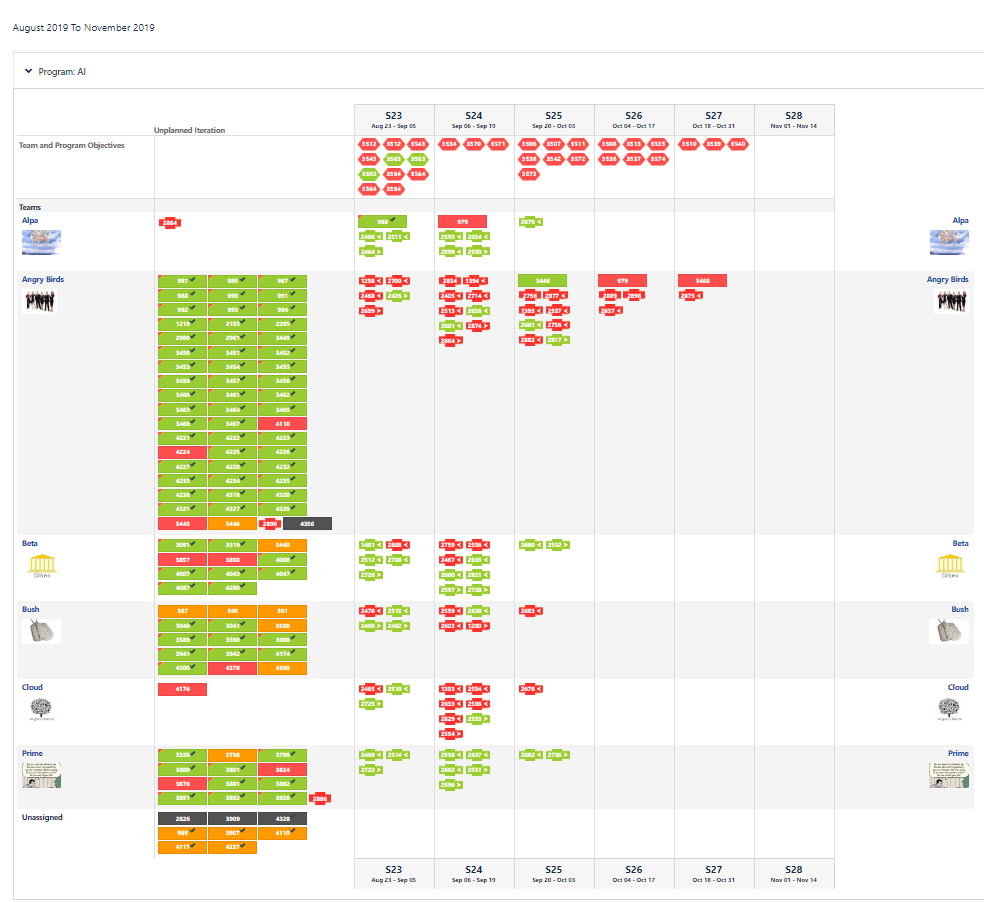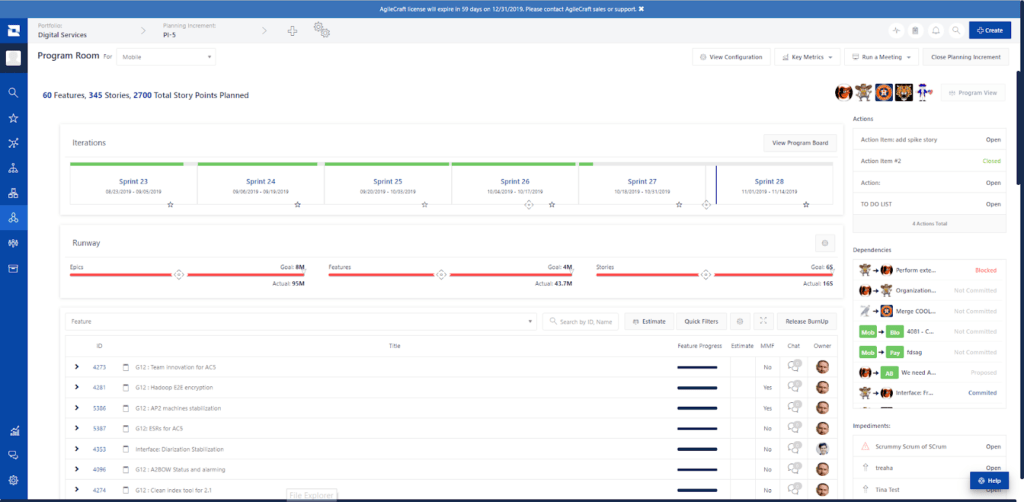The Program Management Team’s Road to Agility with Atlassian Jira Align
In a previous post, we introduced you to Jira Align, the enterprise agile planning and portfolio management tool in the Atlassian suite of solutions. We’re extremely excited about this powerful tool and its seamless integration with Jira and other applications on which so many of our clients rely. So, we’re diving a bit deeper into Jira Align with a series of four articles focused on some of the key user roles:
- Product Manager
- Program Manager/Release Train Engineer (RTE)
- Portfolio Manager
- Executive
In each case, we’ll explore the day-to-day challenges these individuals often face during their enterprise agile journey, and how Jira Align provides real world solutions to those problems.
The Program Manager’s Role
Responsible for the middle ground between the portfolio manager’s broad oversight and the product manager’s narrower focus, the program manager needs to coordinate the activities of a program to achieve the program’s strategic objectives and benefits. As such, the role involves aligning the work of multiple teams and projects (Jira Epics) to achieve the program goals. It also allows for optimized focus on the most value add deliverables.
What is a program manager?
Atlassian has defined the program manager role this way:
“They bring teams together, establish and facilitate communication and planning best practices, and are always looking around corners to make sure future roadblocks can be removed and teams have their best chance to deliver work on time.”
What does a program manager do?
The following day-to-day responsibilities are shared by nearly all program managers:
Strategy / Planning
- Encourage cross-team collaboration including facilitating cross-team meetings
- Coaching teams on Agile and best practices.
- Removing obstacles to effective cross-Team collaboration
- Anticipating, identifying and helping resolve program risks
- Monitoring and helping manage cross-team dependencies supporting cross-team communication and commitment
- Monitoring progress of program execution and working with teams as needed to help mitigate delays, impediments and bottlenecks
- Working with Scrum Masters to help assess impacts of development issues and scope changes on cross-team dependencies and overall execution
- Planning and running SAFe ceremonies such as PI Planning, Inspect and Adapt and System Demos, as the case may be
So, in summary, a program manager needs to align the day-to-day operations and firefighting of several product teams to help guide them toward a successful release at the end of each program increment (PI).
(Note: in organizations using SAFe, the role of Release Train Engineer (RTE) mirrors that of program manager, just as the Release Train mirrors a team of teams supporting the same solution.)
The program manager as juggler
In the last article, we described the product manager like a tightrope walker. In this case, we’ll stay safely on the ground because program managers are more like jugglers. They don’t need to balance their responsibility to the organization with their responsibility to the customer. Like product managers, they need to manage the working infrastructure that allows teams to successfully deliver value.
The juggler is doing something relatively simple — tossing an object in the air and catching it again, — but he’s doing it simultaneously with three, five, maybe ten objects. And, since this is a circus we’re visiting, he’s probably also riding a unicycle.
In order to succeed, he needs to carefully coordinate every toss to keep all the objects in the air at once, without letting them collide or fall. In this illustration, the juggler is the program manager and the objects he’s juggling are the planning, coordination, coaching, facilitating, escalating and mitigating items that come up within the multiple product teams. All those objects need to stay in the air at the same time. Keeping them there can require some impressive feats of organization, management, and alignment.
At its core, juggling is about coordination. And, program management is, too.
The Challenges Facing Program Managers Today
With that in mind, let’s look at some of the challenges that make it difficult to keep everything in the air throughout a typical Program Increment.
Disconnected strategies
The program manager needs to understand for each release (Program Increment) the program objectives and how they relate to the overall business strategy.
For each Program Increment the program teams agree on program objectives and value to be delivered for the release.
Program managers need to closely monitor the work to ensure these commitments are followed, unplanned work is not added, and risks and impediments are communicated. If teams are adding or changing scope or not escalating issues impeding delivery, they may not meet the PI commitments. Failure to achieve the PI Objectives will negatively impact team predictability. As well, it will likely reduce stakeholders ‘trust in the teams’ ability to deliver in the future.
Coordinating and leading the way
The program manager is called upon to coordinate numerous daily and cadence based activities and lead the teams through successful delivery. It would be ideal if accurate data and clear progress metrics were at their fingertips.
Trusting the scrum masters and teams
This challenge is less concrete, but it’s important nonetheless. Trust is a vital component of any successful agile workflow. While the program manager carries a lot of responsibility for ensuring a program runs smoothly and resources are properly allocated, success will remain out of reach if they try to micromanage all of this on their own. There are simply too many people and potential variables that come into play for the program manager to try to optimize everything on their own. So, they need to work closely with scrum masters and, in turn, trust them and their teams to follow through on release delivery effectively.
How Jira Align Helps Program Managers
Jira Align includes a number of powerful features that do an amazing job of solving these common challenges for program managers in the program environment:
Program board
Serving as a digital version of the physical board program managers have been relying on for years, the Program Board within Jira Align provides a robust highly visual hub where all the information related to a Program Increment can be viewed.
The board displays features by sprint (iteration) for each team, team and program PI objectives, team dependencies, impediments, and much more. It delivers a stunning visualization of program cross dependencies. It also provides a deeply satisfying, comprehensive view of resource allocation across projects. But the real magic is the uncanny ability to visually show inefficiencies and gaps that can be swiftly resolved. These might include dependency conflicts, unassigned stories and features not on track.
With all these PI details at your fingertips, you can keep those objects in the air, no problem!
Program room
The Program Room is an in depth tool displaying additional PI execution details the Program Manager utilizes to stay informed of team and program progress. Team velocity, capacity, runway, defect trends, burnup and burndown charts are a few of the added tools available.
For more information about Jira Align, including more details about why program managers love it, watch our free webinar, Discover Jira Align.
In the next article in this series, we’ll explore the portfolio manager role and how Jira Align helps make their lives easier.





